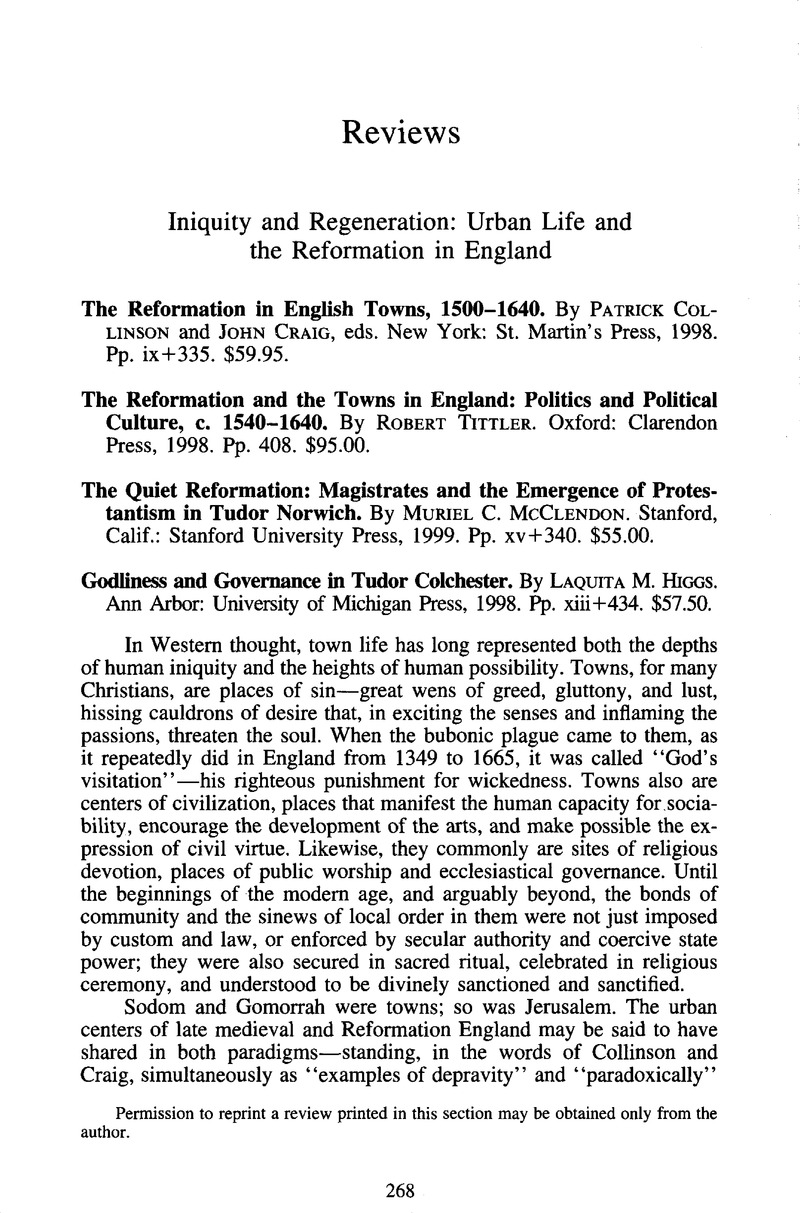No CrossRef data available.
Article contents
Iniquity and Regeneration: Urban Life and the Reformation in England - The Reformation in English Towns, 1500–1640. By Patrick Collinson and John Craig, eds. New York: St. Martin's Press, 1998. Pp. ix + 335. $59.95. - The Reformation and the Towns in England: Politics and Political Culture, c. 1540–1640. By Robert Tittler. Oxford: Clarendon Press, 1998. Pp. 408. $95.00. - The Quiet Reformation: Magistrates and the Emergence of Protestantism in Tudor Norwich. By Muriel C. McClendon. Stanford, Calif.: Stanford University Press, 1999. Pp. xv + 340. $55.00. - Godliness and Governance in Tudor Colchester. By Laquita M. Higgs. Ann Arbor: University of Michigan Press, 1998. Pp. xiii + 434. $57.50.
Published online by Cambridge University Press: 10 January 2014
Abstract

- Type
- Reviews
- Information
- Copyright
- Copyright © North American Conference of British Studies 2001
References
1 I shall use the abbreviation “CC” in designating page references to the essays in Collinson and Craig's volume. Along with thematic essays by Patrick Carter (on the economic problems of the provincial clergy), Peter Cunich (on the dissolution of the chantries), Beat Kümin (on voluntary religion in urban parishes), Robert Tittler (on the acquisition of ecclesiastical properties and problems of authority in Reformation towns), Patrick Collinson (on cultural politics in late Elizabethan Shrewsbury and elsewhere), and Adam Fox (on urban religious satire from 1570 to 1640), the volume offers discussions of religious change and the development of Protestantism in Colchester (Mark Byford), Doncaster (Claire Cross), Beverley (David Lamburn), Tewksbury (Caroline Litzenberger), Worcester (Diarmaid MacCulloch), Reading (Jeanette Martin), and Halifax (William Sheils and Sarah Sheils).
2 Psalm 122:3. This passage forms the “text” for Collinson's, Patrick chapter on towns in his The Birthpangs of Protestant England: Religious and Cultural Change in the Sixteenth and Seventeenth Centuries (New York, 1988); see p. 28Google Scholar.
3 See Mendenhall, T. C., The Shrewsbury Drapers and the Welsh Wool Trade in the Sixteenth and Seventeenth Centuries (London, 1953)Google Scholar, chap. 5.
4 In turning substantively to Tittler's book, I must confess to a personal puzzlement. On the one hand, Tittler's argument sees the general pattern of early modern urban development following lines similar to those that I have suggested were traced by Bristol. Compare, e.g., his comments on the “demise of the traditional doctrinally informed urban political culture” (p. 336) with my “Demise of the Martyrs: The Feasts of St. (Catherine and St. Clement in Bristol, 1400–1660,” Social History 11, no. 2 (May 1986): 141–69Google Scholar, and with chap. 4 in my The Widening Gate: Bristol and the Atlantic Economy, 1450–1700 (Berkeley and Los Angeles, 1991)Google Scholar, neither of which is cited by Tittler at this place. On the other hand, Tittler sometimes misreads my discussion and then raises doubts based on his own misreading. It is difficult to know how to respond, since he does not provide the page references indicating where I am supposed to have drawn “sometimes questionable implications” (p. 172, n. 54) about places other than Bristol about which I wrote nothing; where I have “insufficiently proven” (p. 176, at n. 69) points I did not argue; where I have assumed conclusions (p. 243, n. 87) that I did not reach; where I lend support to “excessive claims” (p. 321, n. 75) that I did not make; or where seemingly I discussed matters “chiefly in social and economic terms” (p. 297, n. 82) when I explicitly put forth an interdisciplinary, multidimensional, and antireductionist argument. I can only invite readers to look at Widening Gate, now accessible as an electronic book on the University of California Press's Web site (http://www.ucpress.berkeley.edu:3030/dynaweb/public/books/history/sacks).
5 Byford, Mark, “The Price of Protestantism: Assessing the Impact of Religious Change on Elizabethan Essex: The Cases of Heydon and Colchester, 1558–1594” (D. Phil, thesis, University of Oxford, 1988)Google Scholar.




